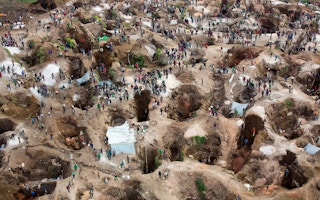Gold, silver, and cobalt are just a few of the precious metals that all smartphone users carry each day. This is common knowledge, but what is less known is how these minerals can represent a meeting point between environmental harm and human exploitation. The intersection between the environmental impacts of sourcing these and other materials used in the production of consumer electronics and goods, and the working conditions of people making these products needs more attention.
To continue reading, subscribe to Eco‑Business.
There's something for everyone. We offer a range of subscription plans.
- Access our stories and receive our Insights Weekly newsletter with the free EB Member plan.
- Unlock unlimited access to our content and archive with EB Circle.
- Publish your content with EB Premium.
The basic argument from leading experts is that where corporate exploitation of human beings is at play, environmental destruction may not be far behind. Indeed, debates even go as far as to suggest that the climate crisis may be unresolvable unless modern slavery numbers significantly drop. From the deepest parts of Central Africa where materials for our tech devices are mined, to the pandemic-fueled need for medical supplies from production lines in Malaysia, across to the demanding fast fashion factories of Mauritius; unsustainable labour practices and ecocide straddle many industries.
Take fast fashion, a vast selection of cheap clothing needed for purchase, pronto. To make this business model work production costs are minimised using cheap, unpaid, or unregulated labour, inexpensive toxins to treat and colour fabric, plus the disposal of pollutants at the smallest price, namely into our oceans and waterways. The result is a pretty garment that is easy on the bank balance, but that literally costs the earth.
As we slowly emerge further into 2021, bleary-eyed from the year the world seemingly came to a halt, our gaze is refocusing on the climate. An underappreciated facet of the climate crisis is its link to forced labour. Solutions to some existential environmental problems may also need to factor in corporate exploitation of humans.
Corporate human rights abuse occurs when there is an overlap between the individual vulnerability of a person’s socio-economic status, societal rejection in part because of poverty, and systems of law failing to protect those with the weakest hand to play. Consumers are far from blameless. The binding glue of corporate exploitation is the insatiable demand for cheap goods, and the necessary army of so-called disposable labourers needed to keep global production flowing.
The issue with unregulated work is precisely that it is unregulated. The legal compliance many workers are treated with in varying forms worldwide is absent. This in turn can be mutually reinforcing of unlawful and harmful environmental practices. Factory owners, plantation managers, and agricultural proprietors who adopt production cultures that involve extensive human exploitation are likely to be ignoring environmental laws and regulations too. Thus, where slavery practices are part of the production line, it is reasonable to ascertain that dangerous toxins, aggressive land clearing, or harmful seafloor scraping may also feature in supply chain processes.
Some firms do not necessarily know it is happening at the furthest reaches of their supply chains. Corporate exploitation of workers can fly under the radar because of convoluted subsidiary supply chains with limited oversight from the parent company. In other words, the big wigs in glass towers sometimes have no idea who is at the end of their supply chain, and in what conditions they toil.
As we progress further into this new decade, decision-makers will likely need to consider how access to technology can better protect workers from exploitation. Some companies are doing an excellent job of trying to change their commercial malpractice, and exploitation in their supply chains has reduced, without negatively affecting profit margins.
For instance, ASOS Plc, a British fashion firm, developed a smartphone app allowing workers at the toughest end of the supply chain in Turkey to report corporate exploitation directly to the parent company in real-time. This shows that things can improve, but it takes a progressive organisational mindset to want to shed light on the dark depths of transnational supply chains.
The United Nations (UN) has set targets under the sustainable development goal 8.7 to eradicate forced labour in all forms by 2030. This is a virtuous end in itself since slavery has undeniably been a societal justice issue in different forms for centuries. The argument also emerging among experts and academics alike is that forced labour has relevance to the climate crisis.
Artificial intelligence and blockchain technology may offer companies a way to have transparency throughout their supply chains. Digital technology is a potential game-changer for understanding how a particular mineral is extracted, the way in which a company’s waste is disposed of, and the conditions of people’s employment. However, technology is never a panacea when it comes to complex problems. For example, biometric fingerprinting and iris scanning—hailed widely to remove the exploitation that can occur when workers’ identity papers are stolen, preventing them from leaving the workplace—comes with its own complicated ethical challenges.
The power dynamics at play until 2030 and beyond will continually jostle between who has the right to demand change and for what purpose. The voices of exploited workers may not always be invited to the table. Decision-makers will need to choose, with transparency, who has the right to decide the next steps on behalf of marginalised workers, whilst ensuring that the changes made will be positively transformative of working conditions. The power, perception and presence of multiple actors and frameworks that currently enable corporate exploitation need to be updated.
The intersection between climate change and forced labour remains underappreciated. Corporations and consumers alike will need to choose actions that positively contribute to a sustainable future, alongside actions that discourage the unsustainable working conditions of the millions of people who produce accessible convenience for so many.











